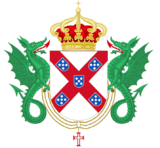Maria I of Portugal
Dona Maria I (English: Mary I; 17 December 1734 – 20 March 1816) was Queen of Portugal from 1777 until her death in 1816. Known as Maria the Pious in Portugal and Maria the Mad in Brazil, she was the first undisputed queen regnant of Portugal and the first monarch of Brazil. With Napoleon's European conquests, her court, then under the direction of her son João, the Prince Regent, moved to Brazil, then a Portuguese colony. Later on, Brazil would be elevated from the rank of a colony to that of a kingdom, with the consequential formation of the United Kingdom of Portugal, Brazil and the Algarves.
| Maria I | |||||
|---|---|---|---|---|---|
_-_Google_Cultural_Institute.jpg) Portrait attributed to Giuseppe Troni, 1783 | |||||
| Queen of Portugal | |||||
| Reign | 24 February 1777 – 20 March 1816 | ||||
| Acclamation | 13 May 1777 | ||||
| Predecessor | Joseph I | ||||
| Co-monarch | Peter III | ||||
| Successor | John VI | ||||
| Regent | John, Prince Regent (1792–1816) | ||||
| Queen of Brazil | |||||
| Reign | 16 December 1815 – 20 March 1816 | ||||
| Successor | John VI | ||||
| Regent | John, Prince Regent | ||||
| Born | 17 December 1734 Ribeira Palace, Lisbon, Kingdom of Portugal | ||||
| Died | 20 March 1816 (aged 81) Carmo Convent, Rio de Janeiro, Kingdom of Brazil | ||||
| Burial | |||||
| Spouse | |||||
| Issue see details... | Joseph, Prince of Brazil Infante John Infante John Francis John VI of Portugal Maria Vitória, Infanta Gabriel of Spain Infanta Maria Clementina Infanta Maria Isabel | ||||
| |||||
| House | Braganza | ||||
| Father | Joseph I of Portugal | ||||
| Mother | Mariana Victoria of Spain | ||||
| Religion | Roman Catholicism | ||||
| Signature |  | ||||
Early life
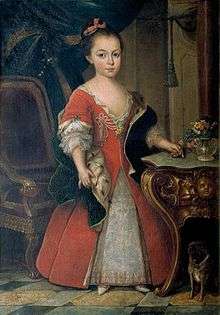
Maria was born at the Ribeira Palace in Lisbon and baptized Maria Francisca Isabel Josefa Antónia Gertrudes Rita Joana. On the day of her birth, her grandfather, King John V of Portugal, appointed her the Princess of Beira.
When her father succeeded to the throne in 1750 as Joseph I, Maria, at age 16 and as his eldest child, became his heir presumptive and was given the traditional titles of Princess of Brazil and Duchess of Braganza.
Influence of the Marquis of Pombal
Maria grew up in a time when her father's government was dominated completely by the first Marquis of Pombal. Her father would often retire to the Palace of Queluz which was later given to Maria and her husband. The Marquis took control of the government after the terrible 1755 Lisbon earthquake of 1 November 1755, in which around 100,000 people lost their lives. (The palace of her birth was also destroyed in the disaster.)[1]
After the earthquake, Maria's father was often uncomfortable at the thought of staying in enclosed spaces, and later suffered from claustrophobia. The king had a palace built in Ajuda, away from the city centre. This palace became known as Real Barraca de Ajuda (Royal Hut at Ajuda) because it was made of wood. The family spent much time at the large palace, and it was the birthplace of Maria's first child. In 1794 the palace burned to the ground and the Palace of Ajuda was built in its place.[1]
In 1760 Maria married her uncle Pedro, younger brother of her father Jose I. They had six children, of whom the eldest surviving son succeeded Maria as João VI on her death in 1816.
Reign

In 1777, Maria became the first undisputed queen regnant of Portugal. With Maria's accession, her husband became king as Peter III. Despite Peter's status as king and the nominal joint reign, the actual regal authority was vested solely in Maria, as she was the lineal heir of the crown. Also, as Peter's kingship was jure uxoris only, his reign would cease in the event of Maria's death, and the crown would pass to Maria's descendants. However, Peter predeceased his wife in 1786. Maria is considered to have been a good ruler in the period prior to her madness. Her first act as queen was to dismiss the popular secretary of state of the kingdom, the Marquess of Pombal, who had broken the power of the reactionary aristocracy via the Távora affair, partially because of Pombal's Enlightenment, anti-Jesuit policies. Noteworthy events of this period include Portugal's membership in the League of Armed Neutrality (July 1782) and the 1781 cession of Delagoa Bay from Austria to Portugal.[2]
Queen Maria suffered from religious mania and melancholia. This acute mental illness (perhaps due to porphyria) made her incapable of handling state affairs after 1792.[3]
Mental deterioration
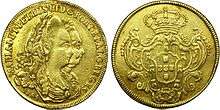
Maria's madness was first officially noticed in 1786, when Maria had to be carried back to her apartments in a state of delirium. Afterward, the queen's mental state became increasingly worse. In May 1786, her husband died; Maria was devastated and forbade any court entertainments. According to a contemporary account, state festivities began to resemble religious ceremonies. Her condition worsened after the death of her eldest son (and heir-apparent), aged 27, from smallpox, and of her confessor, in 1791.[4]
In February 1792, she was deemed mentally insane and was treated by Francis Willis, the same physician who attended King George III of Great Britain. Willis wanted to take her to England, but the plan was refused by the Portuguese court. Maria's second son (eldest surviving) and new heir-apparent, John, took over the government in her name, even though he only took the title of Prince Regent in 1799.[3]
When the Real Barraca de Ajuda burnt down in 1794, the court was forced to move to Queluz, where the ill queen would lie in her apartments all day. Visitors would complain of terrible screams that would echo throughout the palace.
Napoleonic Wars
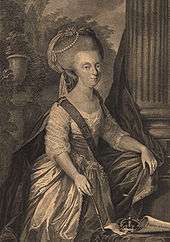
In 1801 Spanish Prime Minister Manuel de Godoy sent an army to invade Portugal with backing from Napoleon, resulting in the War of the Oranges. Though the Spanish ended their invasion, the Treaty of Badajoz on 6 June 1801 forced Portugal to cede Olivença and other border towns to Spain. (This cession is not recognized by the present Portuguese government, and the country officially considers those territories still to be Portuguese possessions.) On 29 September 1801 John VI signed the Treaty of Madrid (1801), ceding half of Portuguese Guyana to France, which became French Guiana.[4]
The refusal of the Portuguese government to join the French-sponsored Continental Blockade against Britain culminated in the late 1807 Franco-Spanish invasion of Portugal led by General Junot. The ultimate Napoleonic plan for Portugal was to split it into three sections. The northern parts of Portugal, from the Douro to the Minho, would become the Kingdom of Northern Lusitania, and its throne was promised to King Louis II of Etruria. The Alentejo Province and Kingdom of the Algarve would be merged to form the Principality of the Algarves, of which Spanish Prime Minister Manuel de Godoy would be sovereign. The remaining portion of Portugal would have been directly ruled by France.[4]
Transfer to Brazil
At the urging of the British government, the entire Braganza Dynasty decided to flee on 29 November 1807 to establish a government in exile in the Portuguese Viceroyalty of Brazil. Along with the royal family, Maria was transported aboard the carrack Príncipe Real. During her move from the royal palace to the docks she was heard screaming throughout the trip, in the middle of the crowd and in the carriage. The queen's dementia was so great that she feared that she was going to be tortured or robbed during her movement by her servants.[2]
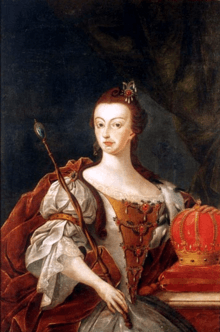
In January 1808 Prince Regent João and his court arrived in Salvador da Bahia. Under pressure by local aristocracy and the British, the prince regent signed a commercial regulation after his arrival that opened commerce between Brazil and friendly nations, which in this case represented the interests of Great Britain above all. This law broke an important colonial pact that had previously allowed Brazil to maintain direct commercial relations only with Portugal.[2]
On 1 August 1808 British General Arthur Wellesley (later Duke of Wellington) landed a British army in Lisbon to initiate the Peninsular War. The impact of Wellesley's initial victory over Junot at the Battle of Vimeiro (21 August 1808) was wiped out by his superiors in the Convention of Cintra (30 August 1808), which allowed the defeated French troops to evacuate peacefully from Portugal.[4]
Wellesley (now as Lord Wellington) returned to Portugal on 22 April 1809 to recommence the campaign. Portuguese forces under British command distinguished themselves in the defence of the Lines of Torres Vedras (1809–1810) and in the subsequent invasion of Spain and France. In 1815 the government of the Prince Regent João elevated Brazil to the status of a kingdom, and Maria I was proclaimed the Queen of the United Kingdom of Portugal, Brazil and the Algarves. When Napoleon was finally defeated in 1815, Maria and her family remained in Brazil.[4]
Death and legacy
Maria lived in Brazil for a total of eight years, always in a state of incapacitation. In 1816, she died at the Carmo Convent in Rio de Janeiro at the age of 81. After her death, Prince Regent João was acclaimed the king of Portugal, Brazil, and the Algarves and his mother's body was returned to Lisbon to be interred in a mausoleum in the Estrela Basilica (Portuguese: Basilica da Estrela), which she had helped found.
Maria is a greatly admired figure in both Brazil and Portugal due to the tremendous changes and events that took place during her reign. In Portugal, she is celebrated as a strong female figure. Her legacy shines at Portugal's Queluz Palace, a baroque-roccoco masterpiece that she helped conceive. A large statue of her stands in front of the palace, and a pousada near the palace is named in her honour. A large marble statue of the queen was erected at the Portuguese National Library in Lisbon by the students of Joaquim Machado de Castro.
In Brazil, she is admired as a key figure in the eventual independence of Brazil. It was during her reign, albeit through the government of her son's regency, that many of the national institutions and organizations in Brazil were created. These institutions were the precursors to their modern-day equivalents and granted large degree of power to the Brazilian colonials. While she is often called A Louca (the Mad) in Brazil, Brazilian and Portuguese historians hold her in high esteem.
Marriage and issue
Maria married her uncle, Infante Pedro of Portugal on 6 June 1760. At the time of their marriage, Maria was 25 and Pedro was 42. Despite the age gap, the couple had a happy marriage. Peter automatically became co-monarch (as Pedro III of Portugal) when Maria ascended the throne, as a child had already been born from their marriage. The couple had six children and a stillborn baby.
| Name | Birth | Death | Notes |
|---|---|---|---|
| José, Prince of Brazil | 20 August 1761 | 11 September 1788 | José Francisco Xavier de Paula Domingos António Agostinho Anastácio married Infanta Benedita of Portugal and had no issue. His death led to his younger brother becoming heir-apparent and later king. |
| João de Bragança | 20 October 1762 | 20 October 1762 | João was a still born baby, born at the Ajuda National Palace. |
| João Francisco de Bragança | 16 September 1763 | 10 October 1763 | João Francisco de Paula Domingos António Carlos Cipriano was born at the Ajuda National Palace. |
| João VI | 13 May 1767 | 10 March 1826 | João Maria José Francisco Xavier de Paula Luís António Domingos Rafael married Carlota Joaquina of Spain and had issue. He was King of Portugal and Titular Emperor of Brazil. |
| Mariana Victoria de Bragança | 15 December 1768 | 2 November 1788 | Maria Ana Vitória Josefa Francisca Xavier de Paula Antonieta Joana Domingas Gabriela married Infante Gabriel of Spain and had issue. |
| Maria Clementina de Bragança | 9 June 1774 | 27 June 1776 | Maria Clementina Francisca Xavier de Paula Ana Josefa Antónia Domingas Feliciana Joana Michaela Julia de Bragança was born at the Queluz National Palace. |
| Maria Isabel de Bragança | 12 December 1776 | 14 January 1777 | Maria Isabel was born at the Queluz National Palace. |
Ancestry
| Ancestors of Maria I of Portugal[5] | |||||||||||||||||||||||||||||||||||||||||||||||||||||||||||||||||||||||||||||||||||||||||||||||||||||||||||||||||||||||||||||||||||||||||||||||||||||||||||||||||||||||||||||||||||||||||||||||||||||||||||||||||||||||||||||||||||||||||||||||||||||||||||||||||||||||||||||||||||||||||
|---|---|---|---|---|---|---|---|---|---|---|---|---|---|---|---|---|---|---|---|---|---|---|---|---|---|---|---|---|---|---|---|---|---|---|---|---|---|---|---|---|---|---|---|---|---|---|---|---|---|---|---|---|---|---|---|---|---|---|---|---|---|---|---|---|---|---|---|---|---|---|---|---|---|---|---|---|---|---|---|---|---|---|---|---|---|---|---|---|---|---|---|---|---|---|---|---|---|---|---|---|---|---|---|---|---|---|---|---|---|---|---|---|---|---|---|---|---|---|---|---|---|---|---|---|---|---|---|---|---|---|---|---|---|---|---|---|---|---|---|---|---|---|---|---|---|---|---|---|---|---|---|---|---|---|---|---|---|---|---|---|---|---|---|---|---|---|---|---|---|---|---|---|---|---|---|---|---|---|---|---|---|---|---|---|---|---|---|---|---|---|---|---|---|---|---|---|---|---|---|---|---|---|---|---|---|---|---|---|---|---|---|---|---|---|---|---|---|---|---|---|---|---|---|---|---|---|---|---|---|---|---|---|---|---|---|---|---|---|---|---|---|---|---|---|---|---|---|---|---|---|---|---|---|---|---|---|---|---|---|---|---|---|---|---|---|---|---|---|---|---|---|---|---|---|---|---|---|---|---|---|---|
| |||||||||||||||||||||||||||||||||||||||||||||||||||||||||||||||||||||||||||||||||||||||||||||||||||||||||||||||||||||||||||||||||||||||||||||||||||||||||||||||||||||||||||||||||||||||||||||||||||||||||||||||||||||||||||||||||||||||||||||||||||||||||||||||||||||||||||||||||||||||||
See also
References
- A history of Portugal. CUP Archive. pp. 352–375.
- Birmingham, David (2018). A Concise History of Portugal. Cambridge University Press. pp. 93–107. ISBN 978-1-108-42419-6.
- History of Portugal: Pamphlet Collection. CUP Archive, 1937. Accessed September 2012.
- A history of Portugal. CUP Archive. pp. 376–403.
- Genealogie ascendante jusqu'au quatrieme degre inclusivement de tous les Rois et Princes de maisons souveraines de l'Europe actuellement vivans [Genealogy up to the fourth degree inclusive of all the Kings and Princes of sovereign houses of Europe currently living] (in French). Bourdeaux: Frederic Guillaume Birnstiel. 1768. p. 14.
Bibliography
- Cheke, Marcus (1947). Carlota Joaquina, Queen of Portugal. London, England: Sidgewick & Jackson. p. 203. ISBN 9780836950403.
miguel.
- Benevides, Francisco da Fonseca. Rainhas de Portugal: Estudo Historico - Volume I. Lisbon, Portugal: Typographia Castro Irmão.
- Benevides, Francisco da Fonseca. Rainhas de Portugal: Estudo Historico - Volume II. Lisbon, Portugal: Typographia Castro Irmão.
- Gomes, Laurentino (2007). 1808 — How a mad queen, a coward prince and a corrupt court fooled Napoleon and changed the History of Portugal and Brazil (in Portuguese). Planeta.
External links

Maria I of Portugal Cadet branch of the House of Aviz Born: 17 December 1734 Died: 20 March 1816 | ||
| Regnal titles | ||
|---|---|---|
| Preceded by Joseph I |
Queen of Portugal 1777–1816 with Peter III (1777–1786) |
Succeeded by John VI |
| Portuguese royalty | ||
| Preceded by Maria Barbara |
Princess of Beira Duchess of Barcelos 1734–1750 |
Succeeded by Joseph |
| Preceded by Joseph |
Princess of Brazil Duchess of Braganza 1750–1777 | |
.png)
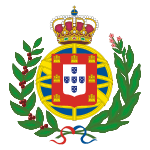
.svg.png)
